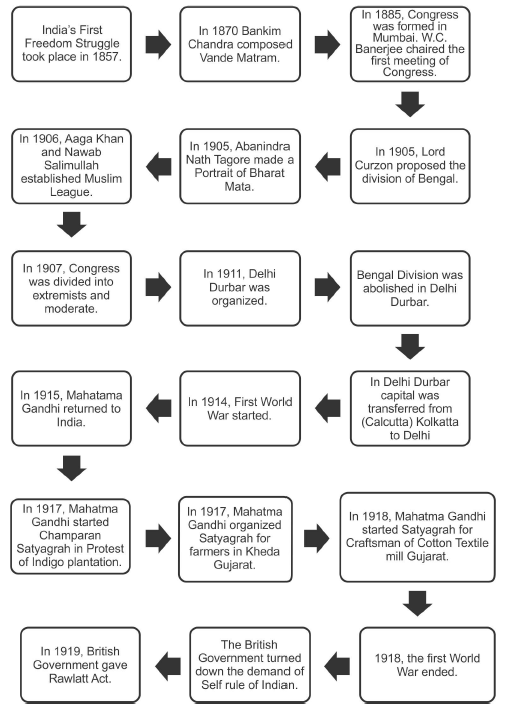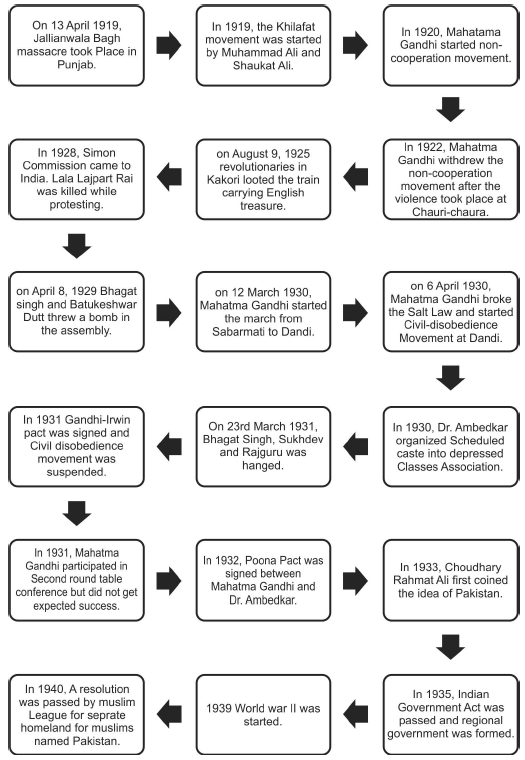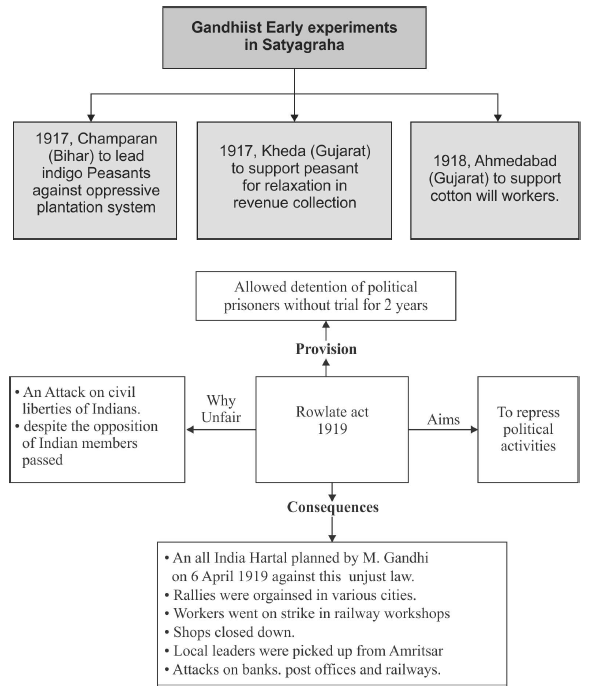Download CBSE Class 10 Social Science Nationalism In India Notes Set B in PDF format. All Revision notes for Class 10 Social Science have been designed as per the latest syllabus and updated chapters given in your textbook for Social Science in Class 10. Our teachers have designed these concept notes for the benefit of Class 10 students. You should use these chapter wise notes for revision on daily basis. These study notes can also be used for learning each chapter and its important and difficult topics or revision just before your exams to help you get better scores in upcoming examinations, You can also use Printable notes for Class 10 Social Science for faster revision of difficult topics and get higher rank. After reading these notes also refer to MCQ questions for Class 10 Social Science given on studiestoday
Revision Notes for Class 10 Social Science India and Contemporary World II Chapter 2 Nationalism in India
Class 10 Social Science students should refer to the following concepts and notes for India and Contemporary World II Chapter 2 Nationalism in India in Class 10. These exam notes for Class 10 Social Science will be very useful for upcoming class tests and examinations and help you to score good marks
India and Contemporary World II Chapter 2 Nationalism in India Notes Class 10 Social Science


Nationalism in India
Meaning : Nationalism refers to the feeling of oneness and common consciousness that energes when people living in a common territory share the same historical, political and cultural back grounds. People may be speaking different languages (as in case of India) but the love for their nation keeps them together.
(The first world war, Khilafat and Non-Cooperation): Effect of first world war on India and Post war condition.
• Creation of a new economic and political situation.
• Huge increase in defence expenditure financed by war loans.
• Increase in taxes, custom duties raised, income tax introduced.
• Forced recruitment in army.
• Shortage of food due to crop failure.
• Inflenza epidemic, famine which resulted in the death of 12 to 13 million people.
Interesting fact
This influenza epidenic was very similar to this corona Pandemic in effects as well as preventive measuses.
The Idea of Satyagraha
Meaning : It was a new mode of struggle based on truth and non violence.
Key features of Satyagraha
• If the cause was true and the struggle was against injustic, then physical force not necessary to fight the oppressor.
• Satyagrahi can win the battle through non-violence without seeking revenge or being aggresive.
• By appealing to the conscience (inner voice) of the oppressor, he/she can be persuaded to see the truth and end injustice.

Jallianwala Bagh Incident
Main Events : Took place on 13 April 1919 in the city of Amritsar.
• A large crowd mainly villgers had gathered in the enclosed ground of Jallianwala bagh to protest against the repressive measures of British govt. like Rawlatt act.
• Being from outside the city, villagers were unaware the meeking was illegal as martial law had been imposed.
• General Dyer entered the area, blocked the exit points, opened fire on the crowd, killing hundreds.
Impact of Jallianwala Bagh
• Crowds took to the streets in many north Indian towns.
• There were strikes, clashes with the police, attacks on government buildings.
• British government became more brutal, people were humiliated and terrorised.
• Satyagrahis were forced to rub their nose on the ground, crawl on the streets, do salaam (Salute) to all sahibs (British).
• People were flogged villages in Punjab around Gujranwala were bombed.
Seeing violence spread, Mahatma Gandhi called off the Rowlatt satyagraha movement.
Khilafat Issue : The word ‘Khilafat’ comes from ‘Khalifa’ who was the ruler of ottoman Turkey as well as considered as the spiritual head of Islamic world. In the first world war Turkey was a part of defeated central powers. There were rumour that a harsh place treaty was going to be imposed on the ottoman emperor. So to defend Khalifa’s position, a khilafat committee was formed in Bombay in March 1919 by Ali brothers.
Why did Mahatma Gandhi took up Khilafat Issue
• M. Gandhi wanted to launch an all India movement more broad based affer the failure of Rowlatt Satyagraha.
• He was certain that no all India movement could be organised without bringing Hindus and Muslims closer together so he took up the Khilafat issue.
Non Cooperation Movement
Different strands within the Movement
• Various social groups participated in the non-cooperation movement but each with its own specific aspiration/demand.
• The term ‘Swaraj’ meant different thing to different people.
• Each Social group participating in the movement imagined ‘Swaraj’ as a time when all their sufferings and troubles would be over.
Towards Civil Disobedience
Events after the end of Non-cooperation Movement (NCM) till the launch of Civil disobedience movement
• February 1922 withdrawl of NCM by Gandhiji.
• Conflict within the congress over the question of participating in council elections.
• Formation of ‘Swaraj Party’ by C-R Das and Motilal Nehru to fight council elections against the congress principle of ‘Boycott’ (January 1923).
• Fall in agricultural prices from 1926 and total collapse due to effect of world wide economic depression.
• Total Turmoil in countryside by 1930.
• Counstitution of Simon commission in 1927 to look into the functioning of the coustitutional system in India and suggest changes.
• 1928: Arrival of Simon commission in India protest and demonstrations started.
• 1929: Offering of ‘Dominion status’ by Lord Irwin.
• Rise of Radical leaders within congress like Jawahrlal Nehru and Subhash Chandra Bose who Demanded ‘Poorna Swaraj’ in Lahore session of the congress 1929.
Round table Conferences
These were a series of 3 peace conferences organised by the British government to discuss constitutional reforms in India.
• Indian national congress attended the second roule table conference only.
The salt March and the Civil disobdience Movemetn (1930).
Background :
• January 1930—Mahatma Gandhi presented 11 demands before lord Irwin.
• These demands were related to different classes—from Industrialists to Peasants.
• Most important Demand—Abolition of Salt tax
• Lord Irwin was not willing to negotiate.
• Beginning of Salt March 1930.
• 6 April 1939—breaking of salt law by manufacturing salt by boiling sea water.
• This marked the beginning of civil disobedience movement.
Limits of Civil disobedience movement
• Non participation of Dalits as for long congress had ignored the demands of scheduled castes.
• Lukewarm (Not very enthusiastic) response of the muslim political organisations as they felt from the mid 1920’s the congress was coming closer to Hindu Nationalist groups like Hindu Mahasabhe.
• An atmosphere of suspicion and distrust between two communities.
The Sense of Collective Belonging
Mahatma Gandhi and the idea of Satyagraha –
The power of Truth & the need to search for truth –Mental strength is more powerful than physical force to win the heart of the oppressor. Novel idea of Satyagraha was first time implemented in South Africa.
In India the first was at Champaran in 1916 – to inspire plantation workers to struggle against oppressive plantation system.
In 1917 Satyagraha at Kheda – to support peasants.
In 1918 Satyagraha at Ahmedabad-Among the cotton mill workers.
“Hind Swaraj – the famous book written by Mahatma Gandhi, which emphasised non-co- operation to British rule in India
The First World War, Khilafat and Non Cooperation
On 13th April 1919 Jallianwalla Bagh Massacre – Amritsar in Punjab The
First World War – its effects.
Huge increases in defenses expenditure. Custom duties were raised; Income tax was introduced. There was forced recruitments in rural areas, spread of epidemics
The Rowlatt Act of 1919: It gave the British government enormous power to repress political activities and allowed detention of political prisoners without trial for two years.
Non-cooperation programme was adopted at Nagpur in Dec.1920.
The peasant movement in Awadh demanded reduction of revenue, abolition of beggar- Baba Ramachandra.
Inland Emigration Act of 1859: Under this act plantation worker were not permitted to leave the tea gardens without permission.
Alluri Sitaram Raju led the tribal revolt of Guden Hills of Andhra Pradesh
Khilafat agitation – led by Muhammad Ali & Shaukat Ali.
Chauri Chaura incident –Violence –withdrawal of Non-Cooperation movement-1922 Swaraj Party was founded by C.R. Das and Moti Lal Nehru for return to council Politics. Simon Commission 1928 and boycott.
Lahore Congress session and demand for Purna Swaraj in 1929. Dandi march and the beginning of civil Disobedience movement
Salt was something consumed by the rich and the poor alike, and it was one of the most essential items of food- salt considered a more effective weapon for protest against Britishers.
Government ‘s repressive policy – Gandhi Irwin Pact and failure of round table conference- Re-launching of movement.
Who participated in the movement?
The rich peasant communities, the poor peasantry, business class, the industrial workers in Nagpur and a large scale participation of women took active part in the movement.
Limits of the movement – less participation by untouchables – Ambedkar for separate electorate and Poona pact of 1932, luke warm response by some Muslim PoliticalOrganization
Provisions of Poona pact of 1932 – Signed between Dr.Ambedkar& Gandhiji – It gave depressed classes reserved seats in central provincial councils but they were to be voted by the general electorate.
The sense of collective belonging- This sense of collective belonging came partly through the experience of united struggles role of folklore and songs- the image of Bharath Mata- Nationalism through icons or symbols of representation of History. The first image was created by Bankim Chandra Chattopadhyay & painted by Abanindra Nath Tagore.
| CBSE Class 10 Social Science Resources And Development Hindi Notes |
| CBSE Class 10 Social Science Resources And Development Notes Set A |
| CBSE Class 10 Social Science Resources And Development Notes Set B |
| CBSE Class 10 Social Science Forests And Wildlife Resources Notes |
| CBSE Class 10 Social Science Water Resources Hindi Notes |
| CBSE Class 10 Social Science Water Resources Notes Set A |
| CBSE Class 10 Social Science Water Resources Notes Set B |
| CBSE Class 10 Social Science Agriculture Hindi Notes |
| CBSE Class 10 Social Science Agriculture Notes Set A |
| CBSE Class 10 Social Science Agriculture Notes Set B |
| CBSE Class 10 Social Science Minerals And Energy Resources Hindi Notes |
| CBSE Class 10 Social Science Minerals And Energy Resources Notes Set A |
| CBSE Class 10 Social Science Minerals And Energy Resources Notes Set B |
| CBSE Class 10 Social Science Manufacturing Industries Hindi Notes |
| CBSE Class 10 Social Science Manufacturing Industries Notes Set A |
| CBSE Class 10 Social Science Manufacturing Industries Notes Set B |
| CBSE Class 10 Social Science Lifelines Of National Economy Hindi Notes |
| CBSE Class 10 Social Science Lifelines Of National Economy Notes Set A |
| CBSE Class 10 Social Science Lifelines Of National Economy Notes Set B |
| CBSE Class 10 Social Science Power Sharing Hindi Notes |
| CBSE Class 10 Social Science Power Sharing Notes |
| CBSE Class 10 Social Science Federalism Hindi Notes |
| CBSE Class 10 Social Science Federalism Notes Set A |
| CBSE Class 10 Social Science Federalism Notes Set B |
| CBSE Class 10 Social Science Gender Religion And Caste Hindi Notes |
| CBSE Class 10 Social Science Gender Religion And Caste Notes Set A |
| CBSE Class 10 Social Science Gender Religion And Caste Notes Set B |
| CBSE Class 10 Social Science Political Parties Hindi Notes |
| CBSE Class 10 Social Science Political Parties Notes Set A |
| CBSE Class 10 Social Science Political Parties Notes Set B |
| CBSE Class 10 Social Science Outcomes Of Democracy Hindi Notes |
| CBSE Class 10 Social Science Outcomes Of Democracy Notes Set A |
| CBSE Class 10 Social Science Outcomes Of Democracy Notes Set B |
| CBSE Class 10 Social Science The Rise Of Nationalism In Europe Notes Set A |
| CBSE Class 10 Social Science The Rise Of Nationalism In Europe Notes Set B |
| CBSE Class 10 Social Science Nationalism In India Hindi Notes |
| CBSE Class 10 Social Science Nationalism In India Notes Set A |
| CBSE Class 10 Social Science Nationalism In India Notes Set B |
| CBSE Class 10 Social Science The Making Of A Global World Hindi Notes |
| CBSE Class 10 Social Science The Making Of A Global World Notes Set A |
| CBSE Class 10 Social Science The Making Of A Global World Notes Set B |
| CBSE Class 10 Social Science The Age Of Industrialization Hindi Notes |
| CBSE Class 10 Social Science The Age Of Industrialization Notes Set A |
| CBSE Class 10 Social Science The Age Of Industrialization Notes Set B |
| CBSE Class 10 Social Science Print Culture And Modern World Notes Set A |
| CBSE Class 10 Social Science Print Culture And Modern World Notes Set B |
| CBSE Class 10 Social Science Print Culture And The Modern World Hindi Notes |
| CBSE Class 10 Social Science Development Hindi Notes |
| CBSE Class 10 Social Science Development Notes Set A |
| CBSE Class 10 Social Science Development Notes Set B |
| CBSE Class 10 Social Science Sectors Of Indian Economy Notes Set A |
| CBSE Class 10 Social Science Sectors Of Indian Economy Notes Set B |
| CBSE Class 10 Social Science Sectors Of The Indian Economy Hindi Notes |
| CBSE Class 10 Social Science Money And Credit Hindi Notes |
| CBSE Class 10 Social Science Money And Credit Notes Set A |
| CBSE Class 10 Social Science Money And Credit Notes Set B |
| CBSE Class 10 Social Science Globalisation And The Indian Economy Hindi Notes |
| CBSE Class 10 Social Science Globalisation And The Indian Economy Notes Set A |
| CBSE Class 10 Social Science Globalisation And The Indian Economy Notes Set B |
| CBSE Class 10 Social Science Globalisation And The Indian Economy Notes Set C |
| CBSE Class 10 Social Science Consumer Rights Hindi Notes |
| CBSE Class 10 Social Science Consumer Rights Notes Set A |
| CBSE Class 10 Social Science Consumer Rights Notes Set B |
CBSE Class 10 Social Science India and Contemporary World II Chapter 2 Nationalism in India Notes
We hope you liked the above notes for topic India and Contemporary World II Chapter 2 Nationalism in India which has been designed as per the latest syllabus for Class 10 Social Science released by CBSE. Students of Class 10 should download and practice the above notes for Class 10 Social Science regularly. All revision notes have been designed for Social Science by referring to the most important topics which the students should learn to get better marks in examinations. Our team of expert teachers have referred to the NCERT book for Class 10 Social Science to design the Social Science Class 10 notes. After reading the notes which have been developed as per the latest books also refer to the NCERT solutions for Class 10 Social Science provided by our teachers. We have also provided a lot of MCQ questions for Class 10 Social Science in the notes so that you can learn the concepts and also solve questions relating to the topics. We have also provided a lot of Worksheets for Class 10 Social Science which you can use to further make yourself stronger in Social Science.
You can download notes for Class 10 Social Science India and Contemporary World II Chapter 2 Nationalism in India for latest academic session from StudiesToday.com
Yes, the notes issued for Class 10 Social Science India and Contemporary World II Chapter 2 Nationalism in India have been made available here for latest CBSE session
There is no charge for the notes for CBSE Class 10 Social Science India and Contemporary World II Chapter 2 Nationalism in India, you can download everything free of charge
www.studiestoday.com is the best website from which you can download latest notes for India and Contemporary World II Chapter 2 Nationalism in India Social Science Class 10
Come to StudiesToday.com to get best quality topic wise notes for Class 10 Social Science India and Contemporary World II Chapter 2 Nationalism in India

